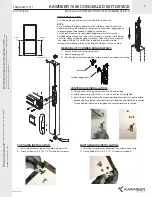
■
■
■
■
Connecting Receiver to Remote TV through VCR
This setup enables you to record transmitted audio and video on your remote
VCR and also enjoy the picture and sound on a remote TV at the same time.
1.
Connect one set of audio/video (A/V) cables to the A/V output jacks of the
receiver and to the A/V input jacks on your VCR.
Note:
Be sure the yellow, red and white plugs match the yellow, red and
white jacks on both the receiver and the VCR. If the VCR has only a single
jack for audio input, connect the white plug to it.
2.
If your TV has A/V input jacks, connect another set of A/V cables to the
TV's A/V input jacks and to the A/V output jacks on your VCR.
3.
If your TV does not have any A/V input jacks, please connect a 75
ohm
coaxial cable from the TV's antenna in (or RF in) to VCR's modulator output.
This feature is optional
4.
Plug one end of the sender power adapter into the back of the receiver and
the other end into any 230-volt (or 120 volt) wall outlet, DC in jack
9V/300mA. Use only the adapter provided.
5.
Locate and orient the receiver to best video and sound quality please
according to the section of this manual titled "Orienting Units for optimum
Performance".
11
E. Orienting Units for Optimum Performance
This sender system should be placed on a flat, stable surface to prevent
damage to it from falling.
For optimum performance, both the audio/video and remote control antennas
should be carefully oriented as described below. In addition, to use the remote
extension feature, the transmitter itself must be specially oriented so it can relay
the converted remote control signal back to the audio/video source (see
following section titled "Using The Remote Control extension Feature"). For
maximum operating range, try to minimize the number of obstacles (e.g. your
TV or other electronics, large furniture) where between the transmitter and
receiver units.
Orienting the Audio/Video Antennas
Sender broadcast their high-quality audio and video using directional antennas,
which must be oriented in certain configurations for best results. The antennas
have been designed to pivot and rotate in-almost any direction.
In most situations, the side with “
” mark face of the antennas on both the
transmitter and receiver should be facing one another and perpendicular (at a
right angle) to an imaginary line drawn between the two units. Three examples
are shown Fig-l, Fig-
2
and Fig-3. Since all homes are different, for optimum
reception, additional slight pivots or rotations may be necessary. If the
transmitter and receiver are less than 10 feet apart, suggest keeping the
antennas flat in their casings since the distance is so short.
REMOTE ANTENNA REMOTE ANTENNA
CONTROL PITTED CONTROL PITTED
ANTENNA SIDE ANTENNA SIDE
TRANSMITTER RECEIVER
( Front View ) (Front View )
Fig-1
: How to orienting the 2.4GHz audio and video antennas.
12




























